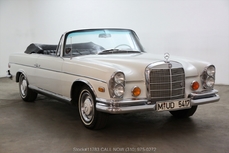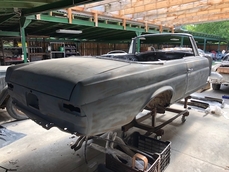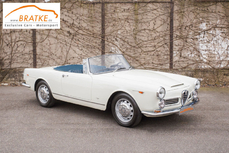Mercedes-Benz 300SE Cabriolet w112 SE W112 Cabriolet deutsch Restauriert 1964
General description :
Im Angebot ein deutsches Mercedes - Benz Cabriolet der Baureihe W 112.
Es entstanden lediglich 708 Cabriolets (W 112.023).
Die W 112 gelten heute nunmehr gerade deshalb und wegen ihrer Seltenheit als die begehrteste Variante.
Des Weiteren sind alle W 112 serienmäßig mit speziellen technischen Besonderheiten ausgestattet. Sie machen den eigentlichen, prestigesichernden Unterschied zu den W 111-Modellen aus:
Sechszylindermotor mit mechanischer Saugrohreinspritzung und zunächst 118 kW (160 PS), ab Februar 1964 mit 125 kW (170 PS)
neuentwickeltes Daimler-Benz-Viergang-Automatikgetriebe
neuentwickelte Luftfederung für konstantes Fahrzeugniveau in allen Belastungs-Situationen
Scheibenbremsen vorn und hinten
Servolenkung
Differentialsperre
Bremsniederhaltung an der Hinterachse für konstanten RadsturzDas hier angebotene Exemplar wurde erstmals im Monat März 1964 in Deutschland / Frankurt a.Main zugelassen. Lediglich bis Monat Juni 1972 im Einsatz gewesen, wurde der Mercedes abgemeldet und ging 38 Jahre frühzeitig in Ruhestand eines Autoliebhabers. Im Jahre 2009 wurde das Fahrzeug wieder zum Leben erweckt und bis 2012 vollständig restauriert. Eine Fotodokumentation liegt vor. Sehr relevant zu erwähnen ist, das der original Kraftfahrzeugbrief (meist als "Pappbrief" betitelt), sowie die Datenkarte vorhanden ist. Der heutige Mercedes Liebhaber und Sammler erwarb den Wagen im Jahr 2012 und ist seither ca. 3000km gefahren. Selbstverständlich nur bei trockenen und sonnigen Wetter. Die meiste Zeit stand der Wagen wohlbehütet in einer beheizten Halle. Das Stoffverdeck in der Farbe "dunkelbraun" präsentiert sich neuwertig, die Lackierung in der Farbe "mittelgrau Metallic" und die Innenausstattung Echtleder in der Farbe "burgunderrot" sind ebenfalls tadellos. Hier sei besonders hervorzuheben, das die extrem seltenen Sporteinzelsitze bei der Restauration verbaut wurden. Diese Sitze von der Fa. Keiper (heute Keiper-Recaro) sind lediglich nur 48mal in diese Modellreihe verbaut wurden! Das Lenkrad in hell-elfenbein und sämtliche Holzeinlagen sind ohne Fehl- und Tadel. Ein außergewöhnliches Fahrzeug, welches in dieser sehr anmuteten Fabkombination nicht ein zweites Mal zu finden sein wird. Weitere Details gerne auf Anfrage. Alle Angaben gemäß Verkaufer, VK erfolgt im Kundenauftrag.
Fahrzeugstandort: Düsseldorf in der Classic Remise ehemals Meilenwerk.
P.S.: Sie möchten sich von Ihrem Oldtimer, Youngtimer oder Sportwagen trennen und haben keine Zeit & Nerven den Verkauf selber in die Hand zu nehmen!? Dann sprechen Sie uns bitte an!
Wir vermitteln und/oder kaufen interessante Fahrzeuge jeglicher Art!
http://home.mobile.de/BRATKE#des_247931853
1964 Mercedes-Benz 300SE Cabriolet w112 SE W112 Cabriolet deutsch Restauriert is listed sold on ClassicDigest in Harffstrasse 110aDE-40591 Düsseldorf by Auto Dealer for €265000.
Car Facts
Car type : Car Make : Mercedes-Benz Model : 300SE Cabriolet w112 Model Version : SE W112 Cabriolet deutsch Restauriert Engine size : 3.0 Model Year : 1964 Sub type : Convertible Location : Harffstrasse 110aDE-40591 Düsseldorf
Sold
Seller Information
Sold
People who viewed this Mercedes-Benz 300SE Cabriolet w112 also viewed similar Mercedes-Benz listed at ClassicDigest
Other cars listed for sale by this dealer
About Mercedes-Benz
In the annals of automotive history, the journey of Mercedes-Benz is a tale that unfolds with the ingenuity of its founding pioneers. In the year 1886, Karl Benz crafted the Benz Patent Motorwagen, a creation that would go down in history as the world's inaugural automobile. Unbeknownst to him, this moment marked the genesis of what would evolve into the most illustrious premium car manufacturer globally. The financial underpinning of this pioneering venture, interestingly, was provided by Karl Benz's wife, Bertha Benz, demonstrating a remarkable partnership that would set the tone for Mercedes-Benz's legacy.A parallel narrative emerged not far away, as Daimler-Motoren-Gesellschaft, founded by Gottlieb Daimler and Wilhelm Maybach, entered the scene. In 1901, they unveiled their automobile under the now-famous moniker "Mercedes," meaning "godsend" in Spanish. This name was bestowed upon the car at the behest of Emil Jellinek's daughter, the distributor for Daimler-Motoren-Gesellschaft. The wheels of innovation were set in motion.
Fast forward to 1926, a pivotal year that witnessed the merger of Daimler with Benz & Cie., culminating in the birth of Daimler-Benz. The amalgamation saw the adoption of "Mercedes-Benz" as the distinguished trademark for their automobiles, fusing the legacies of two visionary entities into one.
Contrary to perceptions of conservatism, the trajectory of Daimler-Benz unfolds as a chronicle of industry firsts. From the introduction of the honeycomb radiator to the float carburetor, and the pioneering implementation of four-wheel brakes in 1924, Daimler-Benz consistently pushed the boundaries of automotive innovation. The diesel-powered Mercedes-Benz 260 D in 1936 marked the inception of diesel engines in passenger cars. The iconic Mercedes-Benz 300SL Gullwing made history as the first car with direct fuel injection, albeit the Gutbrod's tiny 2-stroke engine can claim precedence.
Safety innovations became a hallmark, with Béla Barényi's patented safety cell design in the "Ponton"-models in 1951, featuring front and rear crumple zones. The W116 450SEL 6.9 saw the introduction of the Anti-Lock Brake system (ABS), another pioneering safety feature. From the first production airbags and beyond, the legacy of "firsts" continued to be etched into the fabric of Daimler-Benz.
Over its centennial journey, Mercedes-Benz has not merely produced cars but has sculpted automotive icons. The SSKL, 710 SSK Trossi Roadster, 770K Grosser, 540K Spezial Roadster, 300SL Gullwing, w100 600 Pullman, w111 280SE 3.5 Flachkühler, w113 230SL Pagoda, w109 300 SEL 6.3, and w201 2.3-16 Cosworth stand testament to the brand's commitment to engineering excellence.
The roaring Silver Arrows, or "Silberpfeile," including the W 25, W 125, W154, W165, and W196, created a legacy of dominance on the racetrack. These machines were not merely cars; they were expressions of precision, speed, and an indomitable spirit that left their competitors in the dust.
As Mercedes-Benz marches into the future, it does so not just as an automaker but as a custodian of a legacy, a torchbearer of innovation, and a beacon of automotive excellence. The road ahead is sure to witness the continued fusion of cutting-edge technology, timeless design, and an unwavering commitment to setting new standards in the world of automobiles.
One luminary figure who left an indelible mark was Béla Barényi, often heralded as the "father of passive safety" for his pioneering work in safety engineering. His patented safety cell design, featuring front and rear crumple zones, became a hallmark of Mercedes-Benz's commitment to occupant safety, setting new standards that reverberated throughout the automotive world.
Moving through the chronicles, the collaborative genius of Wilhelm Maybach, alongside Gottlieb Daimler, laid the foundation for Daimler-Motoren-Gesellschaft. Their innovations not only birthed the first Mercedes but established a culture of relentless pursuit of technological excellence that remains integral to Mercedes-Benz's DNA.
In the post-merger era of 1926, Ferdinand Porsche emerged as a prominent figure within Mercedes-Benz. His work on the Mercedes-Benz S-Type, a supercharged race car, garnered acclaim and set the stage for a legacy that extended far beyond the marque. Porsche's impact would later extend to his eponymous company, but his influence at Mercedes-Benz during those formative years was pivotal.
As the 20th century progressed, the legendary Rudolf Uhlenhaut emerged as a key figure. Uhlenhaut, an accomplished engineer and the driving force behind the iconic Silver Arrows, played a crucial role in Mercedes-Benz's dominance in motorsports. His engineering prowess and attention to detail were instrumental in creating some of the most formidable racing cars of the era.
In the latter half of the century, figures like Bruno Sacco, the head of design at Mercedes-Benz from 1975 to 1999, left an indelible imprint on the brand's aesthetic identity. Sacco's design philosophy, characterized by clean lines and timeless elegance, shaped iconic models like the W126 S-Class and the W201 190E, solidifying Mercedes-Benz's reputation for luxury and sophistication.
The narrative would be incomplete without acknowledging the contributions of engineers like Hans Scherenberg, whose leadership in the 1970s ushered in a new era of technological innovation at Mercedes-Benz. Scherenberg's tenure saw the development of groundbreaking technologies, including the Anti-Lock Brake system (ABS) and the introduction of airbags in production cars.











